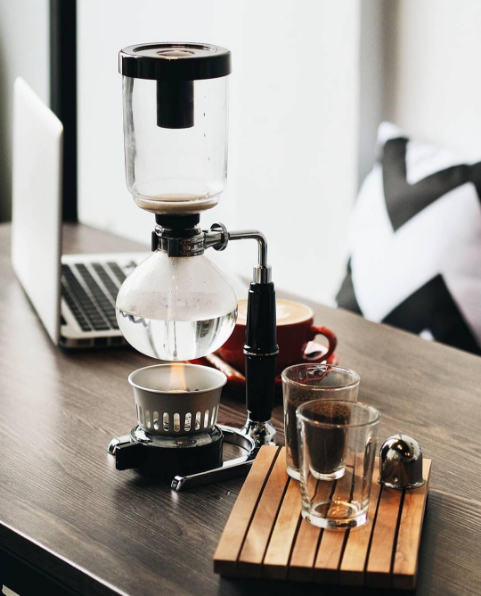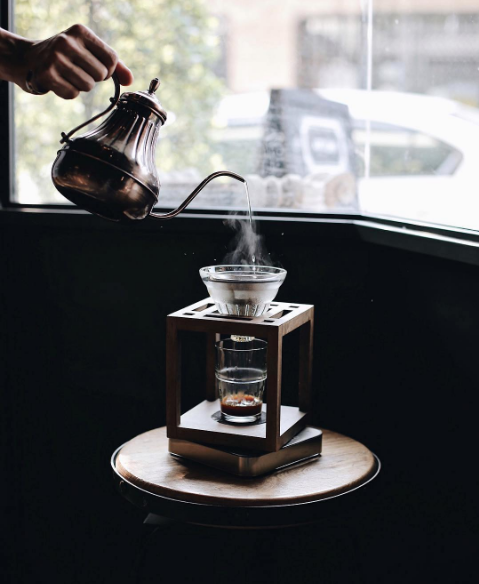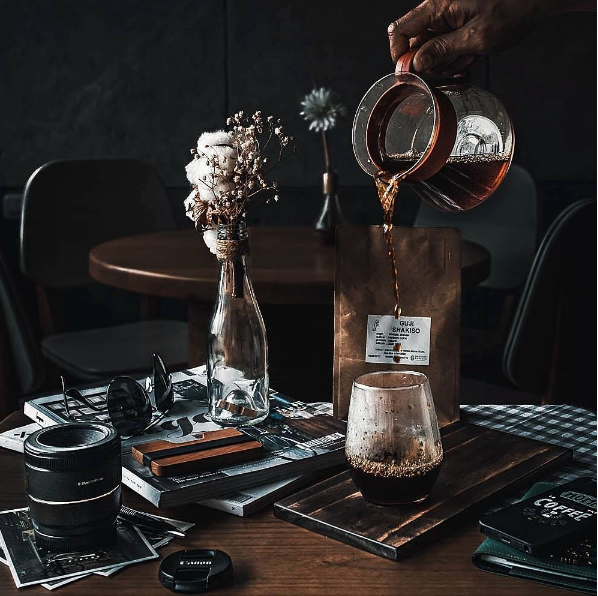What are the extraction principles of hand-brewed coffee
Follow the caf é (Wechat official account vdailycom) and found that Beautiful Cafe opened a small shop of its own.
When extracting coffee
Put the ground coffee powder into the filter cup and fill it with water carefully. The first time to inject a small amount of water, and rest until soaked in coffee powder, and then divided into 3 to 4 times of water injection. Why do we have to divide these steps? This is because the principles of dissolution and diffusion are used in coffee extraction. If we carefully observe the filter cup, we can see the change process of coffee, which plays a reference role in the extraction of coffee. However, the filter paper in the filter cup can not directly see the changes inside, so prepare a set of transparent utensils similar to the filter cup. So how is dissolution and diffusion carried out during extraction?
one
The core principle of hand-brewed coffee is dissolution and diffusion.
During the roasting process, chemical reactions take place within the coffee cells to produce a variety of components that emit the aroma and flavor of the coffee. As a by-product of these chemical reactions, the gas slowly formed inside the coffee causes the cells to expand. These gases and water are expelled through very small pores inside the cell. These countless pores contain the ingredients that dominate the flavor of coffee formed during baking. To dissolve these ingredients, you must first crush the coffee beans and expose as many pores inside the coffee bean cells to the surface as possible. Then slowly inject water, you can dissolve the ingredients of the coffee, this is the dissolution.

In order to dissolve smoothly, we can consider grinding the coffee powder to the finest so that all the ingredients in the cell can be dissolved. However, if you grind it too fine, it is easy to block the filter paper, so in actual extraction, the coffee powder is only ground to the size of sesame grains. In this way, some cells containing coffee are exposed to the surface, while others are not exposed to the surface. There are also some cells that contain coffee ingredients that cannot be broken by crushing. These cells cannot be extracted by dissolution, and the extraction can only be formed by diffusion.
Put the coffee into a filter cup, fill it with a small amount of water until it is soaked, and the coffee begins to expand. This is because hot water soaks into the coffee cells along the capillaries between the coffee cells formed during baking, pushing the gas out of the cells, causing the coffee to expand. The water that enters the coffee cell begins to dissolve the coffee ingredients and form a thick coffee solution. Stand still for a while and then inject water into the filter cup again, when there is a concentration difference between the solution formed in the coffee cell and the newly injected water, and the thick coffee solution begins to push the coffee ingredients into the newly injected water. This process is called diffusion.
In this way, in order to dissolve more smoothly and fully form the diffusion caused by the difference in concentration, the process of formal extraction to the coffee cell for 30 to 40 seconds after the first injection of water is called prior extraction. In this process, coffee has been fully prepared for extraction.
two
The secret is that coffee is in even contact with water.
If you look at the roasted coffee beans under a microscope, you will find that there are many small pores. Because of this porous structure, the coffee powder will float on the surface when injected with water. A close look at the coffee powder floating on the water shows that it has been divided into two layers. The bottom layer because the coffee powder is in full contact with water, resulting in the active dissolution and diffusion of coffee ingredients, but the upper layer is mixed with the gas discharged from the coffee, so the coffee is not in full contact with water. So even if you put in enough coffee powder, some of the coffee ingredients can't be completely dissolved. In order to fully form dissolution and diffusion, the coffee is filled with water and sometimes stirred in the filter cup with a spoon. Stir with a spoon and mix the layered parts again so that the coffee and water can be fully contacted. If you inject water more carefully, you can stir it without a spoon, and the coffee powder can be in full contact with the water.
It is often heard that water injection should be carefully controlled in order to avoid the collapse of the coffee layer. But as you can see in the picture, no matter how fine the water is injected into the coffee powder floating on the water, the falling water still has an impact on the coffee layer on the surface, causing the coffee to sink to the bottom and then rise to the surface again. Because of this phenomenon, coffee and water can be fully and evenly contacted. Water injection itself is to fully stir the water and coffee, so as long as the water and coffee can be fully mixed, regardless of the method of water injection, it does not have much effect on the taste of coffee.
Important Notice :
前街咖啡 FrontStreet Coffee has moved to new addredd:
FrontStreet Coffee Address: 315,Donghua East Road,GuangZhou
Tel:020 38364473
- Prev

Little knowledge sharing of Coffee extraction
What is the appropriate temperature for coffee extraction? In fact, I spent about a day thinking about how to answer this question. It's not that the problem is unfathomable, but that we receive too much information. As you are familiar with, coffee is best at 85, or in many business training sessions, the coffee machine is set at 96. There are also some textbooks that say coffee is at 92.
- Next

What is the reason for the lack of coffee extraction?
Following Cafe Review (Wechat official account vdailycom) found that Beautiful Cafe opened a small shop of its own (Under-extracted Coffee) insufficient extraction means that enough flavor substances in the coffee powder have not been dissolved, and there are still a large number of substances in the coffee powder that have not been extracted. The substance in the coffee powder could have been extracted more to balance it.
Related
- What is the meaning of lactic acid fermentation with coffee bean treatment?
- How to judge the state of foam by sound?
- How does the latte pull out the unicorn pattern? Come to get for a little trick to improve the flower pull!
- Will flower pulling affect the taste of the latte?
- Do you know the history of coffee?
- The difference between honey treatment and sun washing what is raisin honey treatment?
- What kind of milk can a novice use to make coffee foam to keep the foam longer? The correct method and skills of milking tutorial sharing
- Why do washed coffee beans taste sour? Flavor characteristics of washed Coffee
- Introduction to the skill of how to practice the size and height of water injection around the circle of hand-brewed coffee
- How do beginners practice coffee flower drawing from scratch?

